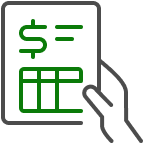Keep in mind that investing involves risk. The value of your investment will fluctuate over time, and you may gain or lose money.
**
Be sure to consider all your available options and the applicable fees and features of each before moving your retirement assets.
1.
The Fidelity Cash Management account is a brokerage account designed for investing, spending and cash management. Investing excludes options and margin trading. For a more traditional brokerage account, consider the Fidelity Account.
2.
The information presented is intended to be educational, should not be considered a recommendation, and is not tailored to the investment needs of any specific investor. Please contact a Fidelity representative for more information or if you would like a recommendation regarding our suite of investment services. We offer a broad range of ways to invest on your own, including access to Fidelity's online planning tools to help you select from many investment options with a range of fees. Learn more.
3.
A distribution from a Traditional IRA is penalty-free provided certain conditions or circumstances are applicable: age 59 1/2; qualified first-time homebuyer (up to $10,000); birth or adoption expense (up to $5,000 per child); emergency expense (up to $1000 per calendar year); qualified higher education expenses; death, terminal illness or disability; health insurance premiums (if you are unemployed); some unreimbursed medical expenses; domestic abuse (up to $10,000); substantially equal period payments; Qualified Federally Declared Disaster Distributions or tax levy.
* The content on this page focuses only on providing educational information related to taking required minimum withdrawals from an original depositor IRA. If you need help with an RMD from an Inherited IRA or retirement account, visit our Inherited IRA RMD page.
After reaching age 73, required minimum distributions (RMDs) must be taken from these types of tax-deferred retirement accounts: Traditional, Rollover, SIMPLE, and SEP IRAs, most 401(k) and 403(b) plans, most small-business accounts (self-employed 401(k), profit sharing plan, and money purchase plan.
Required minimum distribution rules do not apply to Roth IRAs during the lifetime of the original owner, or to participants in 401(k) plans who are less than 5% owners, until they retire. RMDs are also required from 403(b) and 457(b) plans, as well as from SEP IRAs, SARSEPs, and SIMPLE IRAs. Your withdrawals will be included in your taxable income except for any part that was previously taxed (your tax basis).
Recently enacted legislation made a number of changes to the rules regarding defined contribution, defined benefit, and/or individual retirement plans and 529 plans. Information herein may refer to or be based on certain rules in effect prior to this legislation and current rules may differ. As always, before making any decisions about your retirement planning or withdrawals, you should consult with your personal tax advisor.
Fidelity does not provide legal or tax advice. The information herein is general and educational in nature and should not be considered legal or tax advice. Tax laws and regulations are complex and subject to change, which can materially impact investment results. Fidelity cannot guarantee that the information herein is accurate, complete, or timely. Fidelity makes no warranties with regard to such information or results obtained by its use, and disclaims any liability arising out of your use of, or any tax position taken in reliance on, such information. Consult an attorney or tax professional regarding your specific situation.
Fidelity Brokerage Services LLC, Member NYSE, SIPC, 900 Salem Street, Smithfield, RI 02917


 Have you inherited an IRA?
Have you inherited an IRA? 

